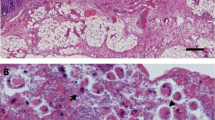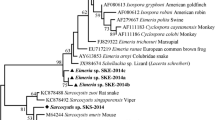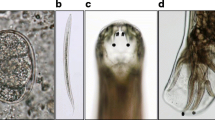Abstract
Human pinworms, Enterobius vermicularis, are normally recognized as minor pathogens. However, a fatal case of human pinworm infection has been reported in a nonhuman primate, a zoo reared chimpanzee. Here, we histopathologically examined the lesions in tissues from the deceased chimpanzee and genetically characterized the isolated worms to investigate the pathogenicity and determine the phylogeny. We identified ulcers deep in the submucosa where many parasites were found to have invaded the lamina propria mucosa or submucous tissue. An inflammatory reaction consisting mainly of neutrophils and lymphocytes but not eosinophils was observed around the parasites, and intense hemorrhage in the lamina propria was confirmed. The parasites were morphologically similar to E. vermicularis based on the shape of the copulatory spicules. Mitochondrial cytochrome c oxidase subunit 1 gene products were amplified from worm DNA by PCR and were genetically identified as E. vermicularis based on >98.7 % similarity of partial sequences. Phylogenetic analysis revealed that the sequences clustered together with other chimpanzee E. vermicularis isolates in a group which has been referred to as type C and which differs from human isolates (type A). The samples were negative for bacterial pathogens and Entamoeba histolytica indicating that E. vermicularis could be pathogenic in chimpanzees. Phylogenetic clustering of the isolates indicated that the parasite may be host specific.




Similar content being viewed by others
References
Arca MJ, Gates RL, Groner JI, Hammond S, Caniano DA (2004) Clinical manifestations of appendiceal pinworms in children: an institutional experience and a review of the literature. Pediatr Surg Int 20:372–375
Ariyarathenam AV, Nachimuthu S, Tang TY, Courtney ED, Harris SA, Harris AM (2010) Enterobius vermicularis infestation of the appendix and management at the time of laparoscopic appendectomy: case series and literature review. Int J Surg 8:466–469
Evangelopoulos A, Spanakos G, Patsoula E, Vakalis N, Legakis N (2000) A nested, multiplex, PCR assay for the simultaneous detection and differentiation of Entamoeba histolytica and Entamoeba dispar in faeces. Ann Trop Med Parasitol 94:233–240
Hamzah Z, Petmitr S, Mungthin M, Leelayoova S, Chavalitshewinkoon-Petmitr P (2006) Differential detection of Entamoeba histolytica, Entamoeba dispar, and Entamoeba moshkovskii by a single-round PCR assay. J Clin Microbiol 44:3196–3200
Hasegawa H, Udono T (2007) Chimpanzee pinworm, Enterobius anthropopitheci (Nematoda: Oxyuridae), maintained for more than twenty years in captive chimpanzees in Japan. J Parasitol 93:850–853
Hasegawa H, Ikeda Y, Fujisaki A, Moscovice LR, Petrzelkova KJ, Kaur T, Huffman MA (2005) Morphology of chimpanzee pinworms, Enterobius (Enterobius) anthropopitheci (Gedoelst, 1916) (Nematoda: Oxyuridae), collected from chimpanzees, Pan troglodytes, on Rubondo Island, Tanzania. J Parasitol 91:1314–1317
Hasegawa H, Greiner EC, Gillespie TR (2008) Morphology of Enterobius (Colobenterobius) colobis Vuylstéke, 1964 (Nematoda: Oxyuridae: Enterobiinae) collected from an ashy red colobus, Procolobus rufomitratus tephrosceles (Elliot, 1907) (Primates: Cercopithecidae: Colobinae), in Uganda. J Parasitol 94:1082–1086
Hasegawa H, Sato H, Fujita S, Nguema PP, Nobusue K, Miyagi K, Kooriyama T, Takenoshita Y, Noda S, Sato A, Morimoto A, Ikeda Y, Nishida T (2010) Molecular identification of the causative agent of human strongyloidiasis acquired in Tanzania: dispersal and diversity of Strongyloides spp. and their hosts. Parasitol Int 59:407–413
Hasegawa H, Sato H, Torii H (2012) Redescription of Enterobius (Enterobius) macaci Yen, 1973 (Nematoda: Oxyuridae: Enterobiinae) based on material collected from wild Japanese macaque, Macaca fuscata (Primates: Cercopithecidae). J Parasitol 98:152–159
Murata K, Hasegawa H, Nakano T, Noda A, Yanai T (2002) Fatal infection with human pinworm, Enterobius vermicularis, in a captive chimpanzee. J Med Primatol 31:104–108
Nakano T, Murata K, Ikeda Y, Hasegawa H (2003) Growth of Enterobius vermicularis in a chimpanzee after anthelmintic treatment. J Parasitol 89:439–843
Nakano T, Fukui D, Ikeda Y, Hasegawa H (2005) Effects of repeated anthelmintic treatment on Enterobius vermicularis infection in chimpanzees. J Parasitol 91:679–682
Nakano T, Okamoto M, Ikeda Y, Hasegawa H (2006) Mitochondrial cytochrome c oxidase subunit 1 gene and nuclear rDNA regions of Enterobius vermicularis parasitic in captive chimpanzees with special reference to its relationship with pinworms in humans. Parasitol Res 100:51–57
Tamura K, Peterson D, Peterson N, Stecher G, Nei M, Kumar S (2011) MEGA5: molecular evolutionary genetics analysis using maximum likelihood, evolutionary distance, and maximum parsimony methods. Mol Biol Evol 28:2731–2739
Tanyuksel M, Petri WA Jr (2003) Laboratory diagnosis of amebiasis. Clin Microbiol 16:713–729
Conflict of interest
The authors declare that they have no conflict of interest.
Author information
Authors and Affiliations
Corresponding author
Rights and permissions
About this article
Cite this article
Yaguchi, Y., Okabayashi, S., Abe, N. et al. Genetic analysis of Enterobius vermicularis isolated from a chimpanzee with lethal hemorrhagic colitis and pathology of the associated lesions. Parasitol Res 113, 4105–4109 (2014). https://doi.org/10.1007/s00436-014-4080-9
Received:
Accepted:
Published:
Issue Date:
DOI: https://doi.org/10.1007/s00436-014-4080-9




